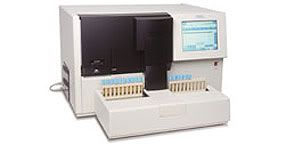On the first two weeks, I've been using the SYSMEX automated blood coagulation analyzer CA-1500.

Picture from http://diagnostics.siemens.com/webapp/wcs/stores/servlet/ProductDisplay~q_catalogId~e_-111~a_catTree~e_100001,1015818~a_langId~e_-111~a_productId~e_182051~a_storeId~e_10001.htm
I feel that this is a great invention! It can do multiple tests such as PT, APTT, D-Dimer Assay, Factor Assays, Protein C Assay, Protein S assay etc. The turnaround time for the tests ordered is fast and it increases productivity rate! However in the Stat Lab, only PT and APTT tests are done. The rest of the tests are sent to the Special Coagulation Lab to do.
So basically when samples arrive, this is what I'll do!
- Collect samples from the Reception Counter
- Remove blood tube from biohazard bag
- Check that the name tally with the request form
- Ensure correct anticoagulant tube is used (citrated ; light blue)
- Check that volume is sufficient
- Assign a lab serial number on the request form and initial name next to it
- Paste the respective barcode label with correct serial number and date on the blood tube
- Before spinning, invert tube to look for big clot
- Centrifuge @ 3000rpm for 3minutes. At the same time, log in request in LIS
- After centrifuging, place them on the sample rack and put on machine's right rack pool ensuring that the barcode labels are facing the scanner in the machine when running.
- Press START on the analyzer screen to run the test
- Record the results on the request form
- Update results in LIS
Therefore the principle of Prothrombin Time (PT) is to screen for abnormalities of factors involved in extrinsic pathway such as factor II, V, VII, X, prothrombin and fibrinogen whereas APTT is a screening test that measures clotting factor of intrinsic pathway such as VIII, IX, XI and XII. These can be easily done by using this automated analyzer to perform the tests! The most commonly ordered tests are PT and APTT. It makes work easier for us because manual PT/APTT is so time-consuming! Remember we did it during the Haem practical? Gosh, it's going to take us hours to complete all the tests ordered! Our lab only do it manually if the first result is out of range and when repeated, result is within the range.
Reference range for PT : 9.0 - 12.5sec
Reference range for APTT : 26.0 - 36.1 sec
The manual test is to confirm the result of the repeated test before recording it in the LIS. However, manual testing is rarely done in our lab!
And thats all for my first few weeks in the Stat Lab! I'll be in the Special Coagulation Lab this week and I'll be learning more other tests!
Till then!
-QINGLING- :D
Hey Qingling!
ReplyDeleteWhat do you mean by citrated and light blue anti-coagulant tube? Is it the one with EDTA? I can't really recall and I haven't come across this "citrated" word! Haha!
Also before spinning, why is it that you still invert the tube to check for clotting? Is this to completely rule out that the tube is faulty or something else?
Yvonee, Group 8
Citrated meaning the blood tube contains sodium citrate as the anticoagulant. Other anticoagulants (eg. Oxalate, heparin or EDTA) are unacceptable in this test. The tube is light blue in colour which helps indicate that it is a citrated blood tube.
ReplyDeleteInverting the tube to check for clotting is necessary because if a clot is present in the blood tube, it shows that the clotting process uses up some of the factors in the blood and this will cause a prolonged PTT result. This will lead to inaccuracy in the result eventually.
Hope I’ve answered to your question! Let me know if you still don’t understand. (:
-QINGLING-